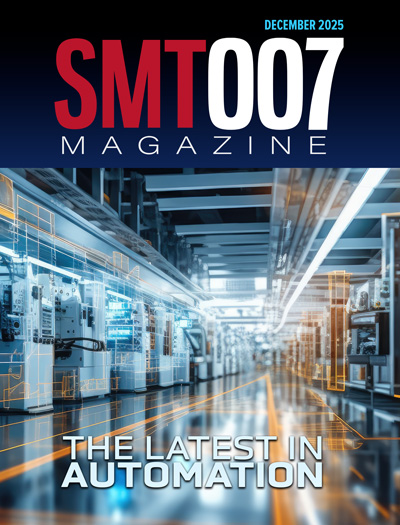-

- News
- Books
Featured Books
- smt007 Magazine
Latest Issues
Current Issue
The Latest in Automation
When customer requirements shift, responses range from new equipment to automation. Explore the newest solutions reshaping production and how today’s market dynamics are driving these trends.

Spotlight on Mexico
Mexico isn’t just part of the electronics manufacturing conversation—it’s leading it. From growing investments to cross-border collaborations, Mexico is fast becoming the center of electronics in North America. This issue includes bilingual content, with all feature articles available in both English and Spanish.

Production Software Integration
EMS companies need advanced software systems to thrive and compete. But these systems require significant effort to integrate and deploy. What is the reality, and how can we make it easier for everyone?
- Articles
- Columns
- Links
- Media kit
||| MENU - smt007 Magazine
Enclosed Media Printing as an Alternative to Metal Blades
June 3, 2015 | Michael L. Martel, Speed line Technologies Inc.Estimated reading time: 2 minutes
Fine pitch/fine feature solder paste printing in PCB assembly has become increasingly difficult as board geometries have become ever more compact. The printing process itself, traditionally the source of 70% of all assembly defects, finds its process window narrowing. The technology of metal blade squeegees, with the aid of new materials, understanding, and settings such as blade angle, has kept pace with all but the smallest applications.
Enclosed media print head technology has existed, and has been under increasing development, as an alternative to metal squeegee blade printing. Until recently, the performance of enclosed print heads had been comparable to the very best metal squeegees, but advances in enclosed print media technology have now made it a superior alternative to squeegee blades in virtually all applications.
Solder paste printing through stencils has long been achieved using metal blades, or squeegees, which replaced polymer squeegee blades due to performance issues years ago. The move from screens to stencils, and then to smaller apertures and fine pitch land patterns, necessitated the change to metal, which offered superior printing performance characteristics.
The evolution of PCBs in terms of the miniaturization of assemblies, components, and ever-finer feature print patterns has not slowed, and as a result continues to present ever-increasing challenges to the makers of assembly equipment and solder paste printing technology, narrowing the process window. Fine pitch and fine feature printing applications, e.g., 200μ–.50 area ratio (AR) and 150μ–.375 AR, have been pushing blade printing technology to its limits.
Skilled printer operators using superior metal blade alloys, varying angle of attack, etc., can achieve acceptable results against the most challenging printing applications, but there are shortcomings that include considerable material waste, which translates into significant cost, less fill volume as apertures become smaller, and unacceptable variation in the consistency of results. Newly developed enclosed print media technologies have been developed as an alternative to metal blade printing. Due to recent advances, enclosed media printing delivers better results overall when measured against ordinary- use metal blades, and they excel in material savings since the print head encloses the solder paste or other media from the surrounding atmosphere, providing steady and uniform results for fine feature apertures filling due to tight process control. For these and other reasons that will be outlined in this paper, they constitute an attractive alternative to metal blade printing.
Editor's Note: This article originally appeared in the May 2015 issue of SMT Magazine.
Testimonial
"Our marketing partnership with I-Connect007 is already delivering. Just a day after our press release went live, we received a direct inquiry about our updated products!"
Rachael Temple - AlltematedSuggested Items
Indium Expert to Tackle Reliability Challenges in AI and High-Performance Computing at EPTC 2025
11/27/2025 | Indium CorporationIndium Corporation Research Metallurgist Huaguang Wang, Ph.D., will deliver a presentation at the 27th IEEE Electronics Packaging Technology Conference (EPTC 2025). The conference will be held December 2-5, 2025, in Singapore.
Altus Supports Concurrent Technologies’ Production Expansion with Advanced Inline Vapour Phase System
11/26/2025 | Altus GroupAltus Group, a leading distributor of capital equipment for the electronics industry, has successfully supplied Concurrent Technologies Plc (Concurrent), a designer and manufacturer of mission-critical embedded computing solutions, with their second ASSCON vapour phase soldering system, the innovative VP2100-100 inline unit.
Knocking Down the Bone Pile: Solderability Test Methods, Myths, and Realities
11/26/2025 | Nash Bell -- Column: Knocking Down the Bone PileSolderability testing answers a simple question: How readily will a termination form a sound solder joint under defined conditions? It is not component preconditioning. Rather, it evaluates wetting—the speed and extent to which molten solder spreads and adheres to a surface—using controlled methods (e.g., visual “dip-and-look” or wetting-balance measurements). Results reflect the combined effects of termination finish, storage and handling, flux activity, and the solder alloy in use.
Indium Experts to Present on Power Electronics at productronica 2025
11/14/2025 | Indium CorporationAs one of the leading materials providers to the power electronics assembly and e-Mobility industries, Indium Corporation® experts will share their technical insight and knowledge on a variety of industry-related topics during Productronica, November 18-21, in Munich, Germany.
ESCATEC Installs Third Wave Soldering Machine in Penang to Meet Growing Demand
11/14/2025 | ESCATECESCATEC’s business unit in Penang, ESCATEC Electronics Sdn Bhd (EEM), recently welcomed the installation of an advanced Ersa POWERFLOW ULTRA wave soldering system, strengthening its capabilities and production capacity for customers bringing complex high-tech products to market.


